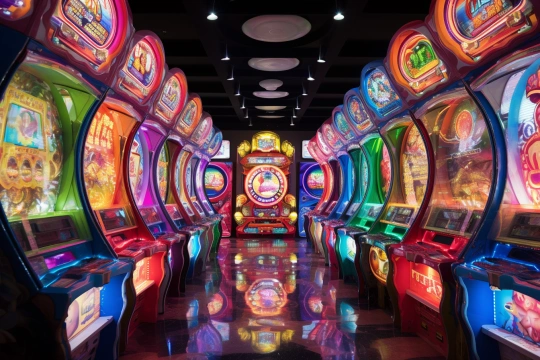A Dive into the World of Pachinko: Embracing Japanese Gambling
Endless flickering lights, the ringing hum of metal balls clashing against the glass, and the sounds of effects merging into a deafening yet mesmerizing chorus - this is what greets anyone who dares to venture into Japan's pachinko parlors for the first time. This game is an integral part of Japanese culture - vibrant, colorful, unpredictable, just like Japan itself.
Pachinko is not merely a gaming machine; it's a distinct phenomenon embodying the spirit of Japanese gambling. In every corner of the country, from the bustling streets of Tokyo to the tranquil suburbs of Fukuoka, you will find pachinko parlors teeming with players of all ages and social statuses. Despite strict regulations governing gambling in most places, Pachinko manages to circumvent these barriers, offering the Japanese a unique opportunity to test their luck.
A Historical Journey Through the World of Pachinko
It's always fascinating to observe how a game or pastime evolves into something more significant, transforming into a cultural phenomenon. Pachinko is an excellent example of such evolution, originating from simple tabletop games and eventually becoming an integral part of the Japanese lifestyle.
The first pachinko machines appeared in Japan in the 1920s, inspired by Western "Corinthian tables" - a game where balls were launched upward and rolled down a board overcoming obstacles. Early games were simple and modest, but they soon began to capture more attention.
During World War II, the production of pachinko was halted due to resource shortages, but after the war ended, it resumed, and pachinko became a popular form of entertainment in the post-war era. The 1960s saw a real boom in pachinko, with parlors springing up all over the country.
Since then, the game has come a long way. Modern pachinko machines are high-tech devices equipped with digital screens and complex mechanisms to provide an engaging and thrilling gaming experience. Despite all the changes and modernizations, the heart of pachinko - the thrill of a random toss of a metal ball - remains constant.
Pachinko today is more than a game; it's part of Japanese culture, a legacy that has stood the test of time and continues to evolve and transform to cater to the ever-changing tastes of players. In the following chapters, we will delve deeper into the world of pachinko to learn about various aspects of this unique game, its rules, strategies, and impact on Japanese culture.
Into the Gameplay: How to Play Pachinko
After the intriguing historical roots of Pachinko, we move on to the heart of the matter - how to play this captivating game? Pachinko machines may appear complex at first glance, but the basics of the game are quite simple.
First, the player purchases a small number of metal balls that are then loaded into the gaming machine. These balls become the "currency" of the game. The player launches the balls into the playfield by spinning a handle on the front panel of the machine. The speed and force with which the balls are launched depend on how hard the handle is turned.
The goal of the game is to get the balls into one of the many holes on the playfield. If a ball goes into a hole, the player earns additional balls that can be used to continue the game or exchanged for prizes.
Modern Pachinko machines often incorporate digital elements, such as built-in video games and special effects, that add extra layers of interaction and strategy. Various "bonus rounds" are common, which could yield additional balls for the player or increase their chances of winning.
Strategy in Pachinko largely depends on luck, but seasoned players claim that controlling the speed and direction of the balls can enhance chances of success. Moreover, the machine you choose to play on can also make a big difference, as each machine has its unique features and mechanics.
So, we've covered the basics of playing Pachinko. In the next chapter, we will dive into the world of different types of Pachinko machines and their unique features.
The Many Faces of Pachinko: Game Variations
Pachinko is not just a game, it's an entire world full of variety. Over time, many variations of pachinko have appeared on the market, offering players different gameplay, design, and complexity options. Let's look at some of the most popular types of pachinko machines.
Hanemono
Hanemono are traditional pachinko machines that were popular in the 1970s and 1980s. They are characterized by simplicity and minimal design. These machines have fewer holes and bonus features, making the game more straightforward. They are ideal for beginners wishing to learn the basics of the game.
Dekkachin
Dekkachin are large, high-tech pachinko machines that were introduced in the 1990s. They typically have a large number of holes and many bonus features. Dekkachin also offer a more complex and unpredictable game, making them popular among experienced players.
Pachislot
Pachislot is a combination of pachinko and a slot machine, where players can win additional balls by matching symbols on rotating drums. This is a relatively new type of machine that adds an extra element of strategy and excitement to the game.
Digital Pachinko
Modern digital pachinko machines use advanced technologies such as LED screens and touch panels to enhance gameplay. They can offer various games and visual effects, as well as interactive bonus rounds, which make them particularly attractive to the younger generation of players.
Different types of pachinko machines offer a wide range of gaming options to satisfy any player's taste, regardless of their level of experience or preferences. In the next chapter, we will look at some strategies that will help you improve your skills and increase your chances of success in this unique and fascinating game.
Success Strategies in Pachinko: Tips and Tricks to Increase Winning Chances
Playing Pachinko, like any other game, requires not only luck but also certain skills. Although Pachinko largely depends on chance, there are some strategies and tips that can help you increase your chances of success.
Speed Control
The speed at which you launch the balls can affect their trajectory and, therefore, which hole they will fall into. Try different speeds to see how it affects your game. In some cases, a slow and calculated approach can be more effective than a fast and aggressive one.
Machine Choice
Not all Pachinko machines are the same. Some may be more generous than others. If you notice that some machines are paying out wins more often, it might be worth choosing them.
Regular Breaks
Remember that playing Pachinko is not only a chance to win but also a great way to relax and have fun. Take regular breaks to avoid fatigue and maintain clarity of thought.
Training and Practice
Finally, as in any other game, experience and knowledge of the game are the keys to success. Try to learn as much as possible about the different aspects of the game and practice to improve your skills.
Playing Pachinko is primarily a matter of pleasure and entertainment. Success in the game comes with time and practice, but the main thing is to enjoy the process.
Pachinko and Japanese Culture: The Game's Influence on Art, Media, and Society
Pachinko is not just a popular game; it's a significant part of contemporary Japanese culture. Its influence extends far beyond the gaming halls and permeates Japanese art, media, and society.
Pachinko in Art and Media
Pachinko frequently appears in Japanese films, anime, and manga, reflecting its status in Japanese society. The game has also become an inspiration for many artists who utilize its bright colors, sparkling lights, and dynamic energy in their works.
Pachinko and Society
Playing Pachinko plays a crucial role in Japan's social life. Pachinko parlors are social spots where people can spend time together, relax, and have fun. Additionally, the game contributes to economic prosperity by creating jobs and generating significant tax revenue.
Pachinko and Visual Culture
Pachinko machines with their bright lights, noisy sounds, and energetic atmosphere significantly influence Japan's visual culture. They are frequently used in advertising and interior design, bringing their unique aesthetic influence.
Playing Pachinko is closely linked with Japanese culture and social life. It not only offers entertainment and socializing opportunities but also contributes to the country's economic prosperity, influences art and media, and shapes visual culture. In the next chapter, we will look at the legal aspects of playing pachinko in Japan and learn what laws regulate this game.
Legal Aspects of Playing Pachinko in Japan
Playing Pachinko, despite its popularity, is not free from legal restrictions in Japan. Indeed, the country's gambling legislation is complex and multifaceted, and Pachinko is no exception.
The Gambling Control Law
The key law regulating Pachinko is the "Gambling Control Law," enacted in 1907. It prohibits most forms of gambling, but Pachinko circumvents this ban because prizes won in the game are usually not directly exchanged for money within the Pachinko parlor.
The "Three Steps" Practice
System known as the "three steps practice". Players exchange their winning balls for certain items or cards inside the Pachinko parlor, which can then be exchanged for cash at a separate location, typically nearby. This workaround allows Pachinko to avoid being classified as gambling under Japanese law.
Regulation and Control
In recent years, discussions have been held about the possible legalization of casinos in Japan, which could lead to changes in legislation concerning Pachinko. This may lead to more control and regulation of the game, as well as a change in its societal status.
In the next chapter, we'll look at the prospects for Pachinko's future development and what changes might occur in this unique and popular game.
Conclusion: Pachinko in the Future - Prospects and Forecasts
Pachinko, despite its long history, remains a vibrant and active element of Japanese culture. But what path awaits this unique game in the future? Let's try to predict some possible scenarios.
The Influence of New Technologies
Technology is increasingly influencing the world of gambling, and Pachinko is no exception. We already see how digital Pachinko machines are replacing traditional mechanical machines. This affects the style of play, visual and sound effects, and ultimately, the overall player experience. This trend can be expected to continue further, with the emergence of even more modern and complex machines.
Casino Legalization
As we mentioned earlier, discussions are underway in Japan about the possible legalization of casinos. If this happens, it could have a significant impact on the Pachinko industry. On the one hand, it may lead to stricter regulation and control over Pachinko parlors. On the other hand, it could open new opportunities for the game's development, such as the introduction of direct cash bets.
Change in Social Perception
Social perception of Pachinko in Japan continues to change. Some people see it as a hobby or form of entertainment, others as a way to relax after a hard day. However, there are also those who consider it a public health problem. The future of Pachinko largely depends on how society will relate to this game.
Influence on Japanese Culture
Pachinko has long become a part of Japanese pop culture, influencing music, cinema, television, and even manga. It remains to be seen how this game will continue to shape and inspire Japanese culture in the future.
Regardless, one thing is clear - Pachinko, this unique and popular game, leaves its unique imprint on Japanese culture and society. Wherever its road leads in the future, it will undoubtedly continue to surprise and delight with its bright lights and exciting moments.



